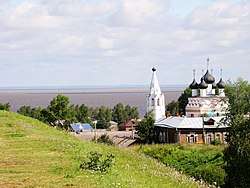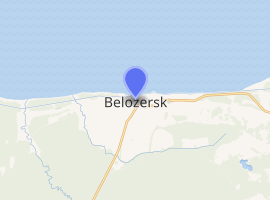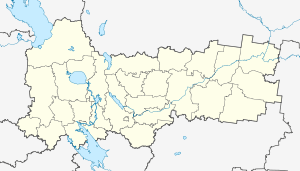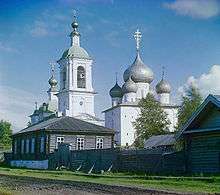Belozersk
Belozersk (Russian: Белозе́рск) is a town and the administrative center of Belozersky District in Vologda Oblast, Russia, located on the southern bank of Lake Beloye, from which it takes the name, 214 kilometers (133 mi) northwest of Vologda, the administrative center of the oblast. Population: 9,616 (2010 Census);[5] 10,975 (2002 Census);[10] 12,352 (1989 Census).[11] It was previously known as Beloozero (until 1777).[12]
Belozersk Белозерск | |
|---|---|
Town[1] | |
 Belozersk with view on Beloye Lake, Vologda Oblast, Russia | |
 Flag  Coat of arms | |
Location of Belozersk 
| |
 Belozersk Location of Belozersk  Belozersk Belozersk (Vologda Oblast) | |
| Coordinates: 60°02′N 37°46′E | |
| Country | Russia |
| Federal subject | Vologda Oblast[1] |
| Administrative district | Belozersky District[1] |
| Town of district significance | Belozersk[2] |
| First mentioned | 862[3] |
| Government | |
| • Body | Town Council[4] |
| Elevation | 130 m (430 ft) |
| Population | |
| • Total | 9,616 |
| • Estimate (2018)[6] | 8,786 (-8.6%) |
| • Capital of | Belozersky District[1], town of district significance of Belozersk[2] |
| • Municipal district | Belozersky Municipal District[7] |
| • Urban settlement | Belozersk Urban Settlement[7] |
| • Capital of | Belozersky Municipal District[7], Belozersk Urban Settlement[7] |
| Time zone | UTC+3 (MSK |
| Postal code(s)[9] | 161200, 161201 |
| Dialing code(s) | +7 81756 |
| OKTMO ID | 19610101001 |
| Website | www |
History
Known as Beloozero (Белоо́зеро, lit. white lake) until 1777,[12] it was first chronicled in 862[3] as one of the five original Russian towns (the other four being Murom, Novgorod, Polotsk, and Rostov).[13] According to the Primary Chronicle, Sineus, a brother of Rurik, became the prince of Beloozero in 862.[14] However, Sineus most likely never existed.[14] On several occasions, the settlement was moved from one bank of the lake to another.[3]
In the 11th century, the region was still inhabited primarily by Finno-Ugric tribes who fiercely resisted Christianization. In 1071, local pagan priests rose in rebellion, which was put down by the Kievan commander Yan Vyshatich. The Primary Chronicle reports that the dead bodies of priests were suspended from an oak tree, until they were torn to pieces by a bear (regarded by pagans as a holy animal). From the 10th to the 13th centuries, the territory was controlled by the Novgorod Republic.[13] Beloozero was the seat of a small principality between 1238 and the 1370s, but subsequently between 1380 and 1384 became subordinate to the Grand Duchy of Moscow.[12][13] On July 10, 1612, Polish and Lithuanian vagabonds (Lisowczycy) captured Belozersk without a fight, looting the town.
In the course of the administrative reform carried out in 1708 by Peter the Great, Beloozero was included into Ingermanland Governorate (known since 1710 as Saint Petersburg Governorate) and named one of the towns constituting the governorate.[15] In 1727, a separate Novgorod Governorate was split off and Belozersk became the seat of Belozersk Province in Novgorod Governorate.[16] In 1776, the territory was transferred to Novgorod Viceroyalty.[12] In 1796, the viceroyalty was abolished and Belozersky Uyezd became a part of Novgorod Governorate.[16]
In June 1918, five uyezds of Novgorod Governorate, including Belozersky Uyezd, were split off to form Cherepovets Governorate, with the administrative center in Cherepovets.[17] On August 1, 1927, Cherepovets Governorate was abolished and its territory became Cherepovets Okrug of Leningrad Oblast.[17] At the same time, uyezds were abolished and Belozersky District was established.[17] On September 23, 1937, Belozersky District was transferred to newly established Vologda Oblast.[17]
Administrative and municipal status
Within the framework of administrative divisions, Belozersk serves as the administrative center of Belozersky District.[1] As an administrative division, it is incorporated within Belozersky District as the town of district significance of Belozersk.[2]
As a municipal division, the town of district significance of Belozersk, together with four rural localities in Glushkovsky Selsoviet and two rural localities in Kunostsky Selsoviet of Belozersky District, is incorporated within Belozersky Municipal District as Belozersk Urban Settlement.[7]
Climate
Belozersk falls just within the subarctic climate range,[18] with the fourth-warmest month being just below the isotherm of 10 °C (50 °F)[19] to nearby humid continental areas. Winters are cold but not severe by Russian standards for areas north of the 60th parallel.
| Climate data for Belozersk | |||||||||||||
|---|---|---|---|---|---|---|---|---|---|---|---|---|---|
| Month | Jan | Feb | Mar | Apr | May | Jun | Jul | Aug | Sep | Oct | Nov | Dec | Year |
| Record high °C (°F) | 11 (52) |
5.9 (42.6) |
14.2 (57.6) |
27.8 (82.0) |
29.8 (85.6) |
33.8 (92.8) |
34 (93) |
33.5 (92.3) |
26.1 (79.0) |
21.9 (71.4) |
12 (54) |
9.5 (49.1) |
34 (93) |
| Average high °C (°F) | −8.7 (16.3) |
−7.5 (18.5) |
−1 (30) |
7.1 (44.8) |
14.4 (57.9) |
19.3 (66.7) |
21.6 (70.9) |
19.3 (66.7) |
13.2 (55.8) |
6 (43) |
−2.1 (28.2) |
−6.6 (20.1) |
6.3 (43.2) |
| Daily mean °C (°F) | −11.6 (11.1) |
−10.5 (13.1) |
−4.8 (23.4) |
2.8 (37.0) |
9.7 (49.5) |
14.8 (58.6) |
17.2 (63.0) |
14.9 (58.8) |
9.5 (49.1) |
3.4 (38.1) |
−4.2 (24.4) |
−8.9 (16.0) |
2.7 (36.8) |
| Average low °C (°F) | −15.3 (4.5) |
−14.2 (6.4) |
−8.9 (16.0) |
−1.7 (28.9) |
4.7 (40.5) |
9.7 (49.5) |
12.2 (54.0) |
10.4 (50.7) |
6 (43) |
0.7 (33.3) |
−6.8 (19.8) |
−12.1 (10.2) |
−1.3 (29.7) |
| Record low °C (°F) | −40 (−40) |
−37.2 (−35.0) |
−33.9 (−29.0) |
−22.8 (−9.0) |
−10 (14) |
−2.9 (26.8) |
1.1 (34.0) |
−2 (28) |
−7.8 (18.0) |
−15.8 (3.6) |
−29.2 (−20.6) |
−40 (−40) |
−40 (−40) |
| Average precipitation mm (inches) | 57 (2.2) |
51 (2.0) |
44 (1.7) |
29 (1.1) |
61 (2.4) |
53 (2.1) |
74 (2.9) |
71 (2.8) |
47 (1.9) |
62 (2.4) |
49 (1.9) |
61 (2.4) |
659 (25.8) |
| Source: [20] | |||||||||||||
Economy
Industry
The economy of Belozersk is based on the timber and food industries.
Transportation
Belozersk is connected by all-seasonal roads with Cherepovets, Kirillov, and Lipin Bor (connecting further to Vytegra). There are also local roads.
The Belozersky Canal, a part of the Volga–Baltic Waterway (formerly known as the Mariinsk Canal System), which connects the river courses of the Sheksna and the Kovzha, runs through Belozersk, bypassing Lake Beloye from the south.
Culture and recreation
The town of Belozersk is classified as a historical town by the Ministry of Culture of Russia, which implies certain restrictions on construction in the historical center.[21]
The medieval monuments in the town center are the Assumption Church (1552) and the Transfiguration Cathedral (1668). The wooden shrine of St. Elijah was built in 1690. The neighborhood is rich in old cloisters, such as Kirillo-Belozersky and Ferapontov Monasteries.
.jpg)

Two of the most famous medieval icons were created in the 13th century in Belozersk: the Virgin of the White Lake and Saints Peter and Paul. They constitute an intermediate style between Novgorodian and Northern icon painting.
The Belozersky Local Museum located in Belozersk is an umbrella organization which not only hosts ethnographic and historical exhibits, but also manages the most important architectural monuments in Belozersk such as the Transfiguration Cathedral.[22]
See also
References
Notes
- Resolution #178
- Law #371-OZ
- Энциклопедия Города России. Moscow: Большая Российская Энциклопедия. 2003. p. 44. ISBN 5-7107-7399-9.
- Official website of Belozersk. Powers of the Town Council (in Russian)
- Russian Federal State Statistics Service (2011). "Всероссийская перепись населения 2010 года. Том 1" [2010 All-Russian Population Census, vol. 1]. Всероссийская перепись населения 2010 года [2010 All-Russia Population Census] (in Russian). Federal State Statistics Service.
- "26. Численность постоянного населения Российской Федерации по муниципальным образованиям на 1 января 2018 года". Federal State Statistics Service. Retrieved January 23, 2019.
- Law #1107-OD
- "Об исчислении времени". Официальный интернет-портал правовой информации (in Russian). June 3, 2011. Retrieved January 19, 2019.
- Почта России. Информационно-вычислительный центр ОАСУ РПО. (Russian Post). Поиск объектов почтовой связи (Postal Objects Search) (in Russian)
- Russian Federal State Statistics Service (May 21, 2004). "Численность населения России, субъектов Российской Федерации в составе федеральных округов, районов, городских поселений, сельских населённых пунктов – районных центров и сельских населённых пунктов с населением 3 тысячи и более человек" [Population of Russia, Its Federal Districts, Federal Subjects, Districts, Urban Localities, Rural Localities—Administrative Centers, and Rural Localities with Population of Over 3,000] (XLS). Всероссийская перепись населения 2002 года [All-Russia Population Census of 2002] (in Russian).
- "Всесоюзная перепись населения 1989 г. Численность наличного населения союзных и автономных республик, автономных областей и округов, краёв, областей, районов, городских поселений и сёл-райцентров" [All Union Population Census of 1989: Present Population of Union and Autonomous Republics, Autonomous Oblasts and Okrugs, Krais, Oblasts, Districts, Urban Settlements, and Villages Serving as District Administrative Centers]. Всесоюзная перепись населения 1989 года [All-Union Population Census of 1989] (in Russian). Институт демографии Национального исследовательского университета: Высшая школа экономики [Institute of Demography at the National Research University: Higher School of Economics]. 1989 – via Demoscope Weekly.
- Н. В. Солдатова (2006). Г. В. Судаков (ed.). Вологодская энциклопедия (PDF) (in Russian). Вологда: ВГПУ, Русь. p. 57. ISBN 5-87822-305-8. Retrieved November 21, 2013.
- Янин, Валентин Лаврентьевич (2008). Очерки истории средневекового Новгорода (in Russian). ISBN 978-5-9551-0256-6.
- Рюрик - Синеус - Трувор. Great Soviet Encyclopedia.
- Указ об учреждении губерний и о росписании к ним городов (in Russian)
- Снытко, О. В.; et al. (2009). С .Д. Трифонов; Т. Б. Чуйкова; Л. В. Федина; А. Э. Дубоносова (eds.). Административно-территориальное деление Новгородской губернии и области 1727-1995 гг. Справочник (PDF) (in Russian). Saint Petersburg. pp. 16–23. Retrieved November 22, 2013.
- "Archived copy" Справка об изменениях административно-территориального устройства и сети партийных и комсомольских органов на территории Вологодской области (1917–1991) (in Russian). Архивы России. Archived from the original on September 17, 2011. Retrieved November 21, 2013.CS1 maint: archived copy as title (link)
- "Belozërsk, Russia, Climate Summary". Weatherbase. Retrieved January 24, 2015.
- "Belozërsk, Russia, Temperature Averages".
- "Belozërsk, Russia, Temperature Averages". Weatherbase. Retrieved January 24, 2015.
- Министерство культуры Российской Федерации. Приказ №418/339 от 29 июля 2010 г. «Об утверждении перечня исторических поселений». Вступил в силу 10 октября 2010 г. Опубликован: "Российская газета", №219, 29 сентября 2010 г.. (Ministry of Culture of the Russian Federation. Order #418/339 of July 29, 2010 On Adopting the Registry of the Historic Settlements. Effective as of October 10, 2010.).
- Белозерский областной краеведческий музей (in Russian). Белозерский областной краеведческий музей. Retrieved November 21, 2013.
Sources
- Законодательное Собрание Вологодской области. Закон №371-ОЗ от 4 июня 1999 г. «О вопросах административно-территориального устройства Вологодской области», в ред. Закона №2916-ОЗ от 7 декабря 2012 г. «О внесении изменений в Закон области "О вопросах административно-территориального устройства Вологодской области"». Вступил в силу со дня официального опубликования. Опубликован: "Красный Север", №124–125, 29 июля 1999 г. (Legislative Assembly of Vologda Oblast. Law #371-OZ of June 4, 1999 On the Matters of the Administrative-Territorial Structure of Vologda Oblast, as amended by the Law #2916-OZ of December 7, 2012 On Amending the Oblast Law "On the Matters of the Administrative-Territorial Structure of Vologda Oblast". Effective as of the day of the official publication.).
- Правительство Вологодской области. Постановление №178 от 1 марта 2010 г. «Об утверждении реестра административно-территориальных единиц Вологодской области», в ред. Постановления №686 от 25 июня 2012 г. «О внесении изменений в некоторые Постановления Правительства области». Вступил в силу 20 марта 2010 г. Опубликован: "Красный Север", №29, 20 марта 2010 г. (Government of Vologda Oblast. Resolution #178 of March 1, 2010 On Adopting the Registry of the Administrative-Territorial Units of Vologda Oblast, as amended by the Resolution #686 of June 25, 2012 On Amending Various Resolutions of the Oblast Government. Effective as of March 20, 2010.).
- Законодательное Собрание Вологодской области. Закон №1107-ОЗ от 6 декабря 2004 г. «Об установлении границ Белозерского муниципального района, границах и статусе муниципальных образований, входящих в его состав», в ред. Закона №3666-ОЗ от 1 июня 2015 г. «О преобразовании некоторых муниципальных образований Белозерского муниципального района, о внесении изменений в Закон области "Об установлении границ Белозерского муниципального района, границах и статусе муниципальных образований, входящих в его состав" и изменения в Приложение к Закону области "О некоторых вопросах организации и деятельности органов местного самоуправления на территории Вологодской области"». Вступил в силу через 10 дней со дня официального опубликования. Опубликован: "Красный Север", №242, 11 декабря 2004 г. (Legislative Assembly of Vologda Oblast. Law #1107-OZ of December 6, 2004 On Establishing the Borders of Belozersky Municipal District, on the Borders and Status of the Municipal Formations It Comprises, as amended by the Law #3666-OZ of June 1, 2015 On the Transformation of Several Municipal Formations in Belozersky Municipal District, on Amending the Law of the Oblast "On Establishing the Borders of Belozersky Municipal District, on the Borders and Status of the Municipal Formations It Comprises", and on Amending the Appendix to the Law of the Oblast "On Various Issues of Organization and Functioning of the Local Self-Government on the Territory of Vologda Oblast". Effective as of after 10 days from the day of the official publication.).